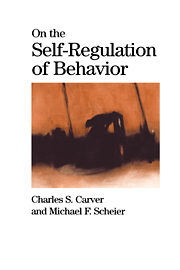Book contents
- Frontmatter
- Contents
- Preface
- Acknowledgments
- 1 Introduction and Plan
- 2 Principles of Feedback Control
- 3 Discrepancy-Reducing Feedback Processes in Behavior
- 4 Discrepancy-Enlarging Loops, and Three Further Issues
- 5 Goals and Behavior
- 6 Goals, Hierarchicality, and Behavior: Further Issues
- 7 Public and Private Aspects of the Self
- 8 Control Processes and Affect
- 9 Affect: Issues and Comparisons
- 10 Expectancies and Disengagement
- 11 Disengagement: Issues and Comparisons
- 12 Applications to Problems in Living
- 13 Hierarchicality and Problems in Living
- 14 Chaos and Dynamic Systems
- 15 Catastrophe Theory
- 16 Further Applications to Problems in Living
- 17 Is Behavior Controlled or Does It Emerge?
- 18 Goal Engagement, Life, and Death
- References
- Name Index
- Subject Index
8 - Control Processes and Affect
Published online by Cambridge University Press: 05 June 2012
- Frontmatter
- Contents
- Preface
- Acknowledgments
- 1 Introduction and Plan
- 2 Principles of Feedback Control
- 3 Discrepancy-Reducing Feedback Processes in Behavior
- 4 Discrepancy-Enlarging Loops, and Three Further Issues
- 5 Goals and Behavior
- 6 Goals, Hierarchicality, and Behavior: Further Issues
- 7 Public and Private Aspects of the Self
- 8 Control Processes and Affect
- 9 Affect: Issues and Comparisons
- 10 Expectancies and Disengagement
- 11 Disengagement: Issues and Comparisons
- 12 Applications to Problems in Living
- 13 Hierarchicality and Problems in Living
- 14 Chaos and Dynamic Systems
- 15 Catastrophe Theory
- 16 Further Applications to Problems in Living
- 17 Is Behavior Controlled or Does It Emerge?
- 18 Goal Engagement, Life, and Death
- References
- Name Index
- Subject Index
Summary
It is the striving toward the known goal that confers unity, not the successful arrival.
(Gordon Allport, Personality: A Psychological Interpretation)And later, much later, he realized it was the going itself, not the arriving, for which he cared.
(Jeffrey A. Carver, Panglor)Much of human behavior is accompanied by feelings, good and bad. During an average day most people experience brief (and sometimes more extended) periods of anxiety, sadness, irritation, and happiness. Often there are also passing moments of guilt, shame, joy, envy, jealousy, and relief. Although most people go through occasional periods in which emotions are relatively absent, affect is an important part of life. Our feelings color our experiences in ways that make those experiences threedimensional. In doing so, feelings tell us critical things about those experiences.
In this chapter, we consider feelings and their origins. Many theorists have analyzed the kinds of information feelings provide and the kinds of situations in which they come to exist (e.g., Frijda, 1986; Izard, 1977; Lazarus, 1991; Ortony, Clore, & Collins, 1988; Roseman, 1984; Scherer & Ekman, 1984). The question we address here is a slightly different one, however: What's the internal mechanism by which good and bad feelings come to arise?
What creates affect? This is a deceptively simple question. Some would say good feelings come from getting what you want – goal attainment – and bad feelings come from failing to get what you want, or from exposure to punishers.
- Type
- Chapter
- Information
- On the Self-Regulation of Behavior , pp. 120 - 147Publisher: Cambridge University PressPrint publication year: 1998
- 2
- Cited by



